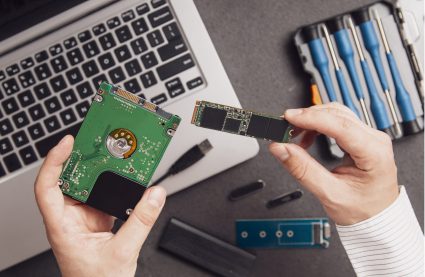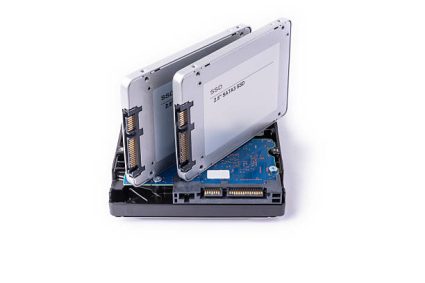
When it comes to choosing a laptop, one of the most important decisions you need to make is between a hard drive and a solid-state drive (SSD). Both have their advantages and disadvantages and the choice ultimately depends on your needs and budget.
Content of the page
What are hard drives and solid-state drives?
A hard drive is a type of non-volatile storage device that stores and retrieves digital information using magnetic recording. It consists of one or more platters, which are magnetically coated discs, and a read/write head that moves along the platter surface to read and write data.
A solid-state drive (SSD) is a type of non-volatile storage device that stores and retrieves digital information using flash memory. Unlike hard drives, SSDs don’t have any moving parts, making them faster and more reliable.
Learn more about other laptops components.
How do hard drives work?
A hard drive works by spinning a magnetically coated disc called a platter at high speeds. The read/write head moves along the platter surface, reading and writing data.
The read/write head uses magnetic fields to read and write data to the platter. When the platter spins, the read/write head is able to detect changes in magnetism. This is how data is read from and written to the platter.
How do solid-state drives work?
A solid-state drive (SSD) uses flash memory to store and retrieve digital information. This type of memory doesn’t require a read/write head and doesn’t have any moving parts, making it faster and more reliable than a hard drive.
Flash memory is made up of cells that contain bits of data. Each cell can be programmed to either store a 0 or a 1. This allows for the storage of digital information in a very small space.
When data is written to an SSD, it is written to the cells that make up the flash memory. This allows for faster access to the data, since there is no need to move a read/write head over the platter.
| Feature | Hard Disk Drive (HDD) | Solid State Drive (SSD) |
|---|---|---|
| Storage Capacity | Typically available in larger capacities, up to several terabytes (TB). | Available in smaller capacities compared to HDD, up to several terabytes (TB). |
| Read/Write Speed | Generally slower than SSD, typically in the range of 100-200 MB/s. | Significantly faster than HDD, typically in the range of 500 MB/s to over 5 GB/s. |
| Fragility | Relatively more fragile due to the presence of moving parts, such as spinning disks and read/write heads. | More durable, with no moving parts that can break. |
| Power Consumption | Typically uses more power than SSD, especially during heavy use. | Uses less power than HDD, resulting in longer battery life and less heat generation. |
| Noise | Produces noise during operation due to the presence of moving parts. | Silent operation due to the absence of moving parts. |
| Price | Generally cheaper per unit of storage compared to SSD. | More expensive per unit of storage compared to HDD. |
| Lifespan | Susceptible to mechanical failure and generally have a shorter lifespan than SSD. | More durable and have a longer lifespan than HDD. |
| Resistance to Shock and Vibration | Susceptible to damage from shock and vibration due to the presence of moving parts. | Resistant to damage from shock and vibration due to the absence of moving parts. |
Performance Comparison
Speed
When it comes to speed, the main difference between a hard drive and a solid state drive (SSD) is the type of memory used to store data. A hard drive uses magnetic storage, while an SSD uses flash memory. This means that an SSD has much faster read and write speeds than a hard drive, resulting in faster boot times, faster application loading times, and improved overall system performance.
Sequential Read and Write Speed
Sequential read and write speed measures how quickly data can be read and written to a storage device. An SSD has a much higher sequential read and write speed than a hard drive, which means it can access and store data much faster. A hard drive typically has a sequential read and write speed of around 125MB/s, while an SSD can reach speeds up to 500MB/s.
Random Read and Write Speed
Random read and write speed measures how quickly a storage device can access and write small chunks of data. An SSD has a much higher random read and write speed than a hard drive, which means it can access and store data much faster. A hard drive typically has a random read and write speed of around 0.1MB/s, while an SSD can reach speeds up to 10MB/s.
Boot Time
Boot time is the amount of time it takes for a computer to start up. An SSD has a much faster boot time than a hard drive, which means it can start up much faster. A hard drive typically has a boot time of around 30-60 seconds, while an SSD can have a boot time of around 10-20 seconds. This can make a big difference when it comes to getting your computer up and running quickly.
Application Load Time
Application load time is the amount of time it takes for an application to start up. An SSD has a much faster application load time than a hard drive, which means applications can start up much faster. A hard drive typically has an application load time of around 5-10 seconds, while an SSD can have an application load time of around 1-2 seconds. This can make a big difference when it comes to getting your applications up and running quickly.
Battery Life
Battery life is the amount of time a device can run on its battery before needing to be recharged. An SSD typically has a better battery life than a hard drive, as it requires less power to access and store data. A hard drive typically has a battery life of around 4-6 hours, while an SSD can have a battery life of up to 8 hours. This can be a big advantage for laptop users who need to be able to use their device for extended periods of time without having to plug it in.
Capacity and Cost Comparison
Storage Capacity
When it comes to storage capacity, hard drives come out on top. Hard drives feature larger storage capacities than solid state drives, allowing you to store more data on them. The most common hard drives have capacities ranging from 500GB to 4TB, while solid state drives are typically limited to 1TB or less. This makes hard drives ideal for storing large amounts of data, such as photos, music, and video files.
Cost per Gigabyte
When it comes to cost, hard drives are much cheaper than solid state drives. While solid state drives can cost up to $0.50 per gigabyte, hard drives can cost as little as $0.03 per gigabyte. This makes hard drives the more economical choice for those looking to store large amounts of data.
Reliability and Durability Comparison
Failure Rates
When it comes to reliability, solid state drives are the clear winner. Solid state drives have a much lower failure rate than hard drives, making them more reliable over the long term. This is due to the fact that hard drives are more susceptible to physical damage, such as shock and vibration, while solid state drives are not.
Shock and Vibration Resistance
Solid state drives are more resistant to shock and vibration than hard drives. This makes them a better choice for those who plan to move their laptop around often, as they are less likely to suffer damage from bumps and drops.
Heat Resistance
Solid state drives are also more resistant to heat than hard drives. This makes them a better choice for those who plan to use their laptop in hot environments, as hard drives can suffer from overheating.
Which One is Better?
When it comes to choosing the right hard drive or solid state drive (SSD) for your laptop, it can be a difficult decision to make. Both types of drives have their advantages and disadvantages and the choice will depend on the specific needs of the user. In this article we will look at the advantages of both hard drives and solid-state drives, and consider the factors to consider when deciding which one is best for you.
Advantages of Hard Drives
There are several advantages to using a hard drive for your laptop. Firstly, hard drives are generally more affordable than solid-state drives, making them an attractive option for those on a budget. Additionally, hard drives usually offer more storage space than solid-state drives and can store more data overall. Finally, hard drives are more reliable and durable than solid-state drives, making them a better option for those who need to store a large amount of data.
Advantages of Solid-State Drives
Solid-state drives (SSD) offer several advantages over traditional hard drives. Firstly, they are much faster than hard drives, meaning that they can access and transfer data much more quickly. Additionally, SSDs are much more reliable than hard drives, making them a great choice for those who need to store sensitive data. Finally, SSDs are much smaller and more lightweight than hard drives, making them a great choice for those who need to carry their laptop around with them.
Considerations for Choosing between Hard Drives and Solid-State Drives
When choosing between a hard drive and a solid-state drive for your laptop, there are several factors to consider. Firstly, consider your budget. Generally speaking, hard drives are more affordable than solid-state drives. However, if you have the budget, it is worth investing in a solid-state drive as they are much faster and more reliable. Secondly, consider the amount of data you are likely to store on your laptop. If you need to store a large amount of data, then a hard drive is the better option. However, if you only need to store a small amount of data, then a solid-state drive is the better option. Finally, consider your lifestyle. If you travel frequently and need to carry your laptop around with you, then the smaller and lighter solid-state drive is the better option.
Conclusion
When choosing between a hard drive and a solid-state drive for your laptop, there are several factors to consider. Firstly, consider your budget and the amount of data you need to store. Hard drives are generally more affordable and offer more storage space, while solid-state drives are faster and more reliable. Secondly, consider how you plan to use your laptop. If you travel frequently and need to carry your laptop with you, then a solid-state drive is the better option. Finally, consider your lifestyle and make the best decision for your needs.
You may want to read next: Laptop Accessories: External Monitors, Docking Stations, and More.

